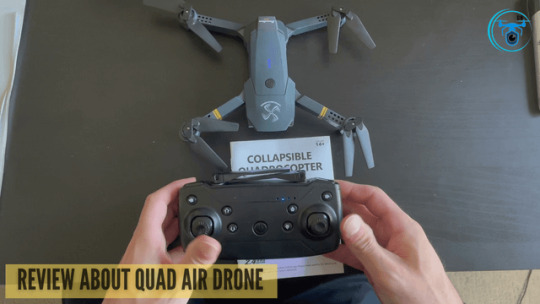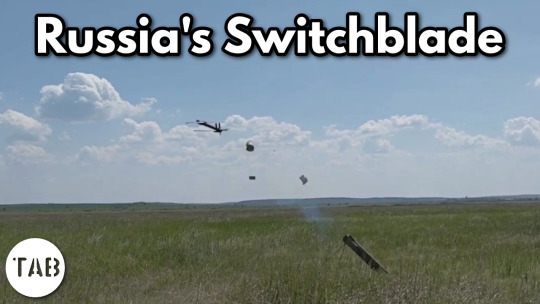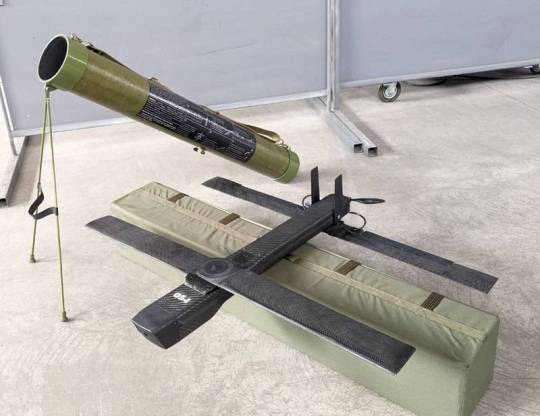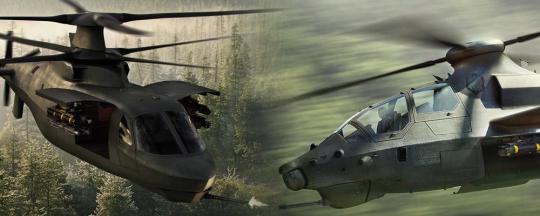#aerovironment
Explore tagged Tumblr posts
Text
Aggiornamenti per gli UAS Puma 3 AE e Puma LE I nuovi aggiornamenti rafforzano i sistemi aerei senza equipaggio (UAS) Puma per mantenere una navigazione affidabile e prestazioni di missione anche quando i segnali GNSS e di comunicazione sono inaffidabili, non disponibili o deliberatamente disturbati
0 notes
Text
Компания AeroVironment представила новый БПЛА P550
Подготовка БПЛА P550 к вылету. Оператор устанавливает модуль полезной нагрузкиАмериканская компания AeroVironment, Inc. активно работает над созданием новых беспилотных летательных аппаратов и регулярно представляет свои новые разработки. На днях компания представила перспективный БПЛА под названием P550. Этот беспилотный самолёт имеет возможность вертикального взлёта и посадки,...... Читать дальше »
0 notes
Link
0 notes
Text

Is the quad air drone a scam? Nowadays, QuadAir Drone is very popular for its high-quality pictures at an affordable price. read more: https://dronesnextup.com/quad-air-drone-dont-be-fooled/
1 note
·
View note
Text
Rheinmetall, AeroVironment jointly bid tactical drones to NATO
Rheinmetall, AeroVironment jointly bid tactical drones to NATO #India #Germany #NATO #USA #Rheinmetall #AeroVironment #drones #UAVs #army #airforce #military #defencenews @SecDef @GermanyDiplo @AmbAckermann @GermanyinIndia @RheinmetallAG @aerovironment
Rheinmetall, AeroVironment offer tactical drones to NATO: German defence company Rheinmetall and US unmanned aircraft systems (UAS) manufacturer AeroVironment have teamed to take part in a NATO special forces project. Group subsidiary Rheinmetall Technical Publications GmbH and AeroVironment have applied to participate in a procurement programme for a small UAS intended for special operations and…

View On WordPress
0 notes
Video
youtube
US Army to Equip Infantry with AeroVironment’s Long-Range Drones
#youtube#USArmy Drones AeroVironment MilitaryTechnology Switchblade PumaDrone WaspIII NanoHummingbird VTOL TomahawkRobotics DefenseInnovation UAV Loi
0 notes
Text


BAS-80: Russia’s Switchblade Loitering Munition
Reports from Russian media outlets announced on 18 September, that Android Technics/Technology, a Russian technology company, had developed an analogue of AeroVironment’s Switchblade 300 loitering munition. Imagery and footage of the BAS-80 was shared by Russian state news outlet RIA.
youtube
Find out more here
#Ukraine War#Loitering Munitions#Switchblade drone#Switchblade 300#BAS-80#Ukraine Russia war#Youtube
78 notes
·
View notes
Text
U.S. to Deploy Thousands of Autonomous Anti-Armor Suicide Drones Against Potential Enemies - autoevolution
8 notes
·
View notes
Text

NASA scientists are close to completing the first-ever accident investigation on another planet. Engineers from NASA’s Southern California Jet Propulsion Laboratory, working with AeroVironment, will publish a report on the final flight of the Ingenuity Mars Helicopter in the coming weeks.
But there is far more good than bad in assessing the cause of the mishap. Ingenuity was originally designed as a technology demonstration, expected to complete five test flights over 30 days. After close to three years, the unique helicopter launched on its 72nd flight on Jan. 18, 2024. According to NASA, “The investigation concludes that the inability of Ingenuity’s navigation system to provide accurate data during the flight likely caused a chain of events that ended the mission.”
The flight was planned as a vertical “hop” to check the Mars helicopter’s flight systems and take more photographs of the surface of the red planet. It climbed to 40 feet above the surface, hovered and captured some images. They it began a 19-second descent, which resulted in “halted communications.”
Ingenuity’s first pilot, Håvard Grip, said, “When running an accident investigation from 100 million miles away, you don’t have any black boxes or eyewitnesses. While multiple scenarios are viable with the available data, we have one we believe is most likely: Lack of surface texture gave the navigation system too little information to work with.”
In all, Ingenuity flew more than two hours of actual flight time on Mars, covering 30 times the distance NASA hoped it would. A black-and-white photo from the aircraft’s navigation camera confirmed rotor damage had occurred during Flight 72.
6 notes
·
View notes
Text
War Profiteers

Remember President Dwight “Ike” Eisenhower, who after green-lighting the overthrow of Iran’s democracy in 1953 at the behest of petrochemical corporations, had a change of heart and warned about the Military Industrial Complex? Here are the top 100 USA Military Industrial Complex “defense” contractors, all corporate welfare queens mooching off the public, who have blood on their hands in Palestine and elsewhere:
Academi
Action Target
ADT Corporation
Advanced Armament Corporation
AECOM
Aerospace Corporation
Aerovironment
AirScan
AM General
American Petroleum Institute
Argon ST
ARINC
Artis
Assett
Astronautics Corporation of America
Atec
Aurora Flight Sciences
Axon Enterprise
United Kingdom BAE Systems
BAE Systems Inc
Ball Corporation
Ball Aerospace & Technologies
Barrett Firearms Manufacturing
Battelle Memorial Institute
Bechtel
Berico Technologies
Boeing Defense, Space & Security
Booz Allen Hamilton
Boston Dynamics
Bravo Strategic
CACI
Carlyle Group
Carnegie Mellon University
Ceradyne
Cloudera
Colt Defense
The Columbia Group
Computer Sciences Corporation
Concurrent Technologies Corporation
CSRA (IT services company)
Cubic Corporation
Omega Training Group
Curtiss-Wright
DeciBel Research
Dillon Aero
Dine Development Corporation
Draper Laboratories
DRS Technologies
DynCorp
Edison Welding Institute
[Israei]l Elbit Systems
M7 Aerospace
Ensco
United Kingdom/Military contractor Ernst & Young
Evergreen International Aviation
Exxon
Fluor Corporation
Force Protection Inc
Foster-Miller
Foster Wheeler
Franklin Armoury
General Atomics
General Dynamics
Bath Iron Works
General Dynamics Electric Boat
Gulfstream
Vangent
General Electric Military Jet Engines Division
Halliburton Corporation
Health Net
Hewlett-Packard
Honeywell
Humana Inc.
Huntington Ingalls Industries
Hybricon Corporation
IBM
Insight Technology
Intelsat
International Resources Group
iRobot
ITT Exelis
Jacobs Engineering Group
JANUS Research Group
Johns Hopkins University
Kaman Aircraft
KBR
Kearfott Corporation
Knight's Armament Company
Kratos Defense & Security Solutions
L3Harris Technologies
Aerojet
Brashear
[France] Lafayette Praetorian Group
Lake Shore Systems
Leidos
EOTech
Lewis Machine & Tool Company
Lockheed Martin
Gyrocam Systems
Sikorsky
LRAD Corporation
ManTech International
Maxar Technologies
McQ
Microsoft
Mission Essential Personnel
Motorola
Natel Electronic Manufacturing Services
Navistar Defense
Nextel
Northrop Grumman
Northrop Grumman Electronic Systems
Northrop Grumman Ship Systems
Northrop Grumman Technical Services
Northrop Grumman Innovation Systems
NOVA
Oceaneering International
Olin Corporation; also see John M. Olin and John M. Olin Foundation
Oshkosh Corporation
Para-Ordnance
Perot Systems
Picatinny Arsenal
Pinnacle Armor
Precision Castparts Corporation
Raytheon Technologies
Collins Aerospace
Rockwell Collins
Goodrich Corporation
Pratt & Whitney
Raytheon Intelligence & Space
Raytheon Missiles & Defense
Raytheon BBN
Remington Arms
Rock Island Arsenal
Roundhill Group
Ruger
Saab Sensis
Science Applications International Corporation (SAIC)
SGIS
Sierra Nevada Corporation
Smith & Wesson
Smith Enterprise (SEI)
SPRATA
Springfield Armory
SRC Inc
SRI International
Stanley
Stewart & Stevenson
Swift Engineering
Tactical Air Support
Teledyne
Teledyne FLIR
Textron
AAI Corporation
Bell Helicopter Textron
Trijicon
TriWest Healthcare Alliance
Unisys
U.S. Ordnance
Verizon Communications
Vinnell Corporation
Westinghouse Electric Corporation
8 notes
·
View notes
Text

U.S. Army cancels FARA program after observations on Ukraine's battlefield
The U.S. Army said it continues to learn from the battlefield, especially in Ukraine, and that air reconnaissance has changed fundamentally.
Fernando Valduga By Fernando Valduga 02/09/2024 - 10:22am Helicopters, Military
The U.S. Army decided to end its ambitious Future Attack Reconnaissance Aircraft (FARA) program, a measure attributed to observations on the battlefield in Ukraine.
This decision, which represents one of the most notable cancellations in the recent history of the U.S. Department of Defense, comes despite an investment of at least $2 billion and an additional request of $5 billion for the next five years.
Launched in 2018 with great expectations, the FARA program aimed to revolutionize approaches to acquiring complex and expensive weapon systems. Prototypes of industry leaders Bell Textron (Bell 360 Invictus) and Sikorsky of Lockheed Martin (Raider X) were expected to take off this year, filling the gap in the armed recognition left by the retirement of the OH-58 Kiowa Warrior helicopter.

The closure of the FARA program left industry partners disappointed, with Sikorsky and Bell Textron expressing confidence in their prototypes and disappointment with the Army's decision.
On Thursday, the Army's top acquisition officers outlined a new vision for their aviation strategy, not only discontinuing the FARA program, but also dismantling their entire fleet of Shadow and Raven unmanned aircraft. The U.S. Army inventory included more than 575 Shadows and 19,000 Ravens.

Sikorsky Raider X.
Doug Bush, head of acquisitions of the Army, announced the decision to stop the deployment of the Black Hawk UH-60 utility helicopter model Victor for the Army National Guard, opting for the UH-60 model Mike, the last variant used by the active force. The acquisition of the next generation helicopter engine has also been postponed. The resources released with these decisions will be redirected to strengthen the existing Army fleet, investing in Black Hawks, the latest variant of the CH-47F Block II Chinook cargo helicopter, the Future Long-Range Assault Aircraft (FLRAA) program and research and development efforts to improve unmanned aerial reconnaissance capacity.
The change from a manned helicopter to armed reconnaissance missions is rooted in the evolution of the war scenario, influenced by the observations of the conflict in Ukraine. In a statement, the Chief of Staff of the Army, General Randy George, said: "We are learning from the battlefield, especially in Ukraine, that air reconnaissance has fundamentally changed... Sensors and weapons mounted on a variety of unmanned systems and in space are more ubiquitous, more far-reaching and cheaper than ever."

UAS RQ-7B Shadow.

UAS RQ-11B Raven.
The U.S. Army plans to complete FARA's prototyping activities by the end of fiscal year 2024, providing service and industry with an opportunity to transfer technology development to other programs. Although specific financial details have not been disclosed, the U.S. Army intends to allocate more funds for the recognition of Unmanned Air Systems (UAS) that are capable of surviving high-level combat, including the Tactical UAS of the Future and LEs (launched efects).
The withdrawal of a part of the Shadow fleet, developed during the counter-insurgency years, and the aged Raven platform are part of the Army's broader plan to replace them with a Tactical UAS of the Future. After a competitive process, AeroVironment initially received a $8 million contract in 2022, and the Army has since reduced the selection to Textron and Griffon Aerospace, both currently building prototypes in the hope of securing an FTUAS production contract.
Tags: 360 InvictusMilitary AviationBell HelicoptersFARA -Future Attack Reconnaissance AircraftHelicoptersRAIDER XsikorskyUS Army - U.S. Army
Sharing
tweet
Fernando Valduga
Fernando Valduga
Aviation photographer and pilot since 1992, he has participated in several events and air operations, such as Cruzex, AirVenture, Dayton Airshow and FIDAE. He has works published in specialized aviation magazines in Brazil and abroad. He uses Canon equipment during his photographic work in the world of aviation.
Related news
EMBRAER
IMAGES: Hungary's first Embraer C-390 Millennium is
09/02/2024 - 09:09
MILITARY
Greece evaluates sale of Mirage 2000 jets to India
08/02/2024 - 19:28
HELICOPTERS
France buys more NH90 helicopters for its Special Operations Forces
08/02/2024 - 18:25
MILITARY
Ukraine launches new 'Kamikaze' jet drone against Russia
08/02/2024 - 17:15
MILITARY
RAF Globemaster takes British Army Apache attack helicopters to the Arctic
08/02/2024 - 15:12
MILITARY
US approves sale of aerostatic radar systems to Poland for $1.2 billion
08/02/2024 - 14:19
5 notes
·
View notes
Text
Switchblade per US Army e Paesi Alleati AeroVironment fornirà loitering munitions Switchblade al US Army ed a Paesi Alleati, tra cui Svezia, Romania e Lituania
#Forze_Armate#Forze_Speciali#Forze_Terrestri#AeroVironment#lituania#loitering_munition#romania#stati_uniti#svezia#Switchblade_600#us_army
0 notes
Text
Electric Vehicle Charger (EVC) Market: Trends, Opportunities, and Forecast

Electric Vehicle Charger (EVC) Market: Trends, Opportunities, and Forecast
The global Electric Vehicle Charger (EVC) Market size was valued at USD 6135 Million in 2021 and is projected to reach from USD XX Million in 2022 to USD 52728 Million by 2030, growing at a CAGR of 27% during the forecast period (2022–2030). Electric vehicle chargers are devices that supply electric energy to electric vehicles, enabling them to operate. The growing adoption of electric vehicles is driving the demand for electric vehicle chargers.
Free Request Sample:https://straitsresearch.com/report/electric-vehicle-charger-market/request-sample
Industry Key Trends
Some of the key trends in the electric vehicle charger market include:
Increasing adoption of electric vehicles : The growing concern about climate change and government initiatives to promote the adoption of electric vehicles are driving the demand for electric vehicle chargers.
Advancements in charging technology : The development of fast-charging technologies, such as DC Fast Charging, is making electric vehicle charging more convenient and efficient.
Growing investment in electric vehicle charging infrastructure : Governments and companies are investing heavily in the development of electric vehicle charging infrastructure, which is driving the demand for electric vehicle chargers.
Increasing focus on sustainability : The growing concern about climate change and the need to reduce greenhouse gas emissions are driving the demand for sustainable transportation solutions, including electric vehicles and electric vehicle chargers.
Electric Vehicle Charger (EVC) Market Size and Share
The global electric vehicle charger market size was valued at USD 6135 Million in 2021 and is projected to reach USD 52728 Million by 2030, growing at a CAGR of 27% during the forecast period.
Electric Vehicle Charger (EVC) Market Statistics
Some of the key statistics in the electric vehicle charger market include:
The market is expected to grow at a CAGR of 27% during the forecast period.
The battery electric vehicle segment is expected to account for the largest share of the market.
The onboard chargers segment is expected to account for the largest share of the market.
Regional Trends
The electric vehicle charger market can be segmented into four regions: North America, APAC, Europe, and LAMEA.
North America
The North American electric vehicle charger market is driven by the growing adoption of electric vehicles in the region. The United States is the largest market in the region, followed by Canada and Mexico.
APAC
The APAC electric vehicle charger market is driven by the rapid growth of the electric vehicle market in countries such as China, Japan, and South Korea.
Europe
The European electric vehicle charger market is driven by the growing adoption of electric vehicles in the region. Germany is the largest market in the region, followed by the UK, France, and Italy.
LAMEA
The LAMEA electric vehicle charger market is driven by the growing adoption of electric vehicles in countries such as Brazil, South Africa, and Turkey.
Electric Vehicle Charger (EVC) Market Segmentations
The electric vehicle charger market can be segmented based on vehicle type, charging type, and end-user.
By Vehicle Type
Battery Electric Vehicle (BEV)
Plug-in Hybrid Electric Vehicle (PHEV)
Hybrid Electric Vehicle (HEV)
By Charging Type
Onboard Chargers
Off-board Chargers
By End User
Residential
Commercial
Market Segmentation: https://straitsresearch.com/report/electric-vehicle-charger-market/segmentation
Top Players in Electric Vehicle Charger (EVC) Market
ABB Ltd.
Robert Bosch GmbH
Siemens AG
Delphi Automotive
Chroma ATE
Aerovironment Inc.
Silicon Laboratories
Chargemaster PLC
Schaffner Holdings AG
POD Point.
Detailed Table of Content report: @https://straitsresearch.com/report/electric-vehicle-charger-market/toc
0 notes
Text
Global Mobile Cardiac Telemetry Systems Market: Trends, Opportunities, and Challenges by 2031
The market for MCT Systems is currently growing very rapidly due to the prevalence of cardiovascular diseases, advances in technology, and increased usage of remote patient monitoring solutions. MCT systems allow continuous cardiac activity monitoring outside the clinical environment. This enables healthcare providers to take early interventions to improve patient outcomes.
In 2023, the size of the mobile cardiac telemetry systems market was at US$ 0.74 billion, and by 2031, it is expected to reach US$ 2.26 billion. Further, this is likely to gain a CAGR of 12.2% during 2023-2031.
Market Dynamics
There are several key growth enablers for the MCT systems market:
Increasing incidence of Cardiovascular Diseases: Cardiovascular diseases are the killers of the world. Full control over management of those conditions is quite possible due to early diagnosis and suitable time of treatment. MCTs can offer consistent, reliable, and accessible continuous monitoring of the heart.
Technological Advancements: Advanced technologies such as wireless communicationand miniaturized sensors have improved the functionality and usability of MCT systems. The advancement in technologies has led to more comfortable, smaller devices with improved data transmission capabilities.
Increasing Adoption of Remote Patient Monitoring: Remote patient monitoring is an effective and cost-efficient mode of healthcare delivery. MCT systems are part of the RPM solutions, which enables healthcare providers to monitor patients and intervene promptly in case of abnormalities.
Increasing Geriatric Population: The geriatric population has the ease of getting cardiac diseases. Since the population of elders is increasing, the requirement of cardiac monitoring systems, for instance, MCT, is expected to increase as well.
Market Segmentation
On Basis Of Technology • Lead Based • Patch Based
On Basis of End User • Hospitals • Ambulatory Surgical Centers • Cardiac centers
On Basis of Region • North America • Europe • Asia-Pacific • South and Central America • Middle East and Africa
Competitive Landscape
• Israel Aerospace Industries IAI • Northrop Grumman Corporation • Yamaha Motorsports • Aviation Industry Corporation of China AVIC • UMS Skeldar • UAVOS Inc • Delft Dynamics • Schiebel Group • AeroVironment Inc • Kaman Aerospace
Future Opportunities
The MCT systems market seems promising in the future. Several factors will drive its growth:
Integration with Artificial Intelligence (AI): AI analytics can be used to further enhance the interpretation of ECG data, which allows for earlier detection of a potential cardiac event and improved management of patients.
Wearable Devices: MCT capabilities can be integrated into wearable devices, such as smartwatches and fitness trackers, for continuous, non-intrusive cardiac monitoring.
Cloud-Based Solutions: It would provide cloud-based solutions offering secure data storage, remote access, and real-time monitoring of patient data.
Conclusion-
The MCT systems market will witness significant growth in the near future as cardiovascular diseases grow in incidence, technology advances, and the remote patient monitoring solution gains more acceptance. In this regard, the next generations of MCT systems are likely to find integration with other health technologies and therefore enhance patient care and outcomes.
Frequently Asked Questions-
Which is the largest regional market for Mobile Cardiac Telemetry Systems? Ans: - North America is the largest regional market for Mobile Cardiac Telemetry Systems.
Which are the top companies to hold the market share in the Mobile Cardiac Telemetry Systems market? Ans: - Medtronic, BioTelemetry Inc. Philips, Applied Cardiac Systems Inc., Medicomp Inc., Preventice Solutions Inc Boston Scientific Corporation, The Scottcare Corporation, Medicalgorithmics SA, Zoll Medical Corporation Asahi Kasei Group, Telerhythmics LLC, iRhythm Technologies Inc are the top companies to hold the market share.
What will be the growth rate of the market during the forecast period of 2023 to 2031? Ans: - The Market for Mobile Cardiac Telemetry Systems is expected to grow at a compound annual growth rate of 12.2% between the forecast period of 2023 to 2031.
How big is the Mobile Cardiac Telemetry Systems market? Ans: The size of the global Mobile Cardiac Telemetry Systems market was US$ 0.74 billion in the year 2023 and will rise to US$ 2.26 billion in 2031.
Which are the sub-segments of the Mobile Cardiac Telemetry Systems market? Ans: - The Mobile Cardiac Telemetry Systems market is classified into Technology, End User, and region.
About Us-
The Insight Partners is among the leading market research and consulting firms in the world. We take pride in delivering exclusive reports along with sophisticated strategic and tactical insights into the industry. Reports are generated through a combination of primary and secondary research, solely aimed at giving our clientele a knowledge-based insight into the market and domain. This is done to assist clients in making wiser business decisions. A holistic perspective in every study undertaken forms an integral part of our research methodology and makes the report unique and reliable.
0 notes
Text

Την υλοποίηση του προγράμματος απόκτησης drone που έχει αποφασίσει από το 2023 το ΓΕΕΘΑ ενέκρινε το ΚΥΣΕΑ στη συνεδρίαση της Παρασκευής 14 Δεκεμβρίου, το οποίο έχει ανακοινωθεί ότι χρηματοδοτηθεί κατά 70% από αμερικανικές πιστώσεις. Μεταξύ άλλων, το ΚΥΣΕΑ ενέκρινε το πρόγραμμα αγοράς drones «έξυπνων» πυρομαχικών Switchblade 300 και Switchblade 600, ύψους 75,2 εκατ. ευρώ. Το Κογκρέσο των ΗΠΑ έχεζι εγκρίνει για την Ελλάδα, λόγω της βοήθειας που προσέφερε στον πόλεμο της Ουκρανίας πιστώσεις 55 εκατ. δολαρίων, που συνεπάγεται ότι θα καλυφθεί περίπου το 70% της συνολικής δαπάνης. Όπερ σημαίνει ότι η Ελλάδα θα επενδύσει τελικά γύρω στα 20 με 25 εκατ. Η συνολική χρηματοδότηση του προγράμματος ήταν αυτή που ανάγκασε και τις ένοπλες δυνάμεις να εγκαταλείψουν τον αρχικό σχεδιασμό για διαμοιρασμό της προμήθειας σε δύο εταιρίες, την ισραηλινή Aeronautics που προσέφερε το Orbiter 1K και την αμερικανική AeroVironment με το Switchblade. Η συμφωνία περιλαμβάνει τις δύο εκδόσεις Switchblade, εξομοιωτές εκπαίδευσης, μονάδες χειρισμού και πρόγραμμα εν συνεχεία υποστήριξης και, σύμφωνα με πληροφορίες, θα υλοποιηθεί σε σύντομο χρονικό διάστημα. Εξίσου γρήγορη θα είναι και η ενσωμάτωση των συστημάτων στις μονάδες των ενόπλων δυνάμεων, οι οποίες διαθέτουν ήδη σημαντική εμπειρία από ασκήσεις και συνεκπαιδεύσεις με τους Αμερικανούς. Οι ένοπλες δυνάμεις θα προμηθευτούν δύο τύπους drone «καμικάζι», 390 συστήματα Switchblade 300 και 200 συστήματα Switchblade 600 καθώς και 76 μονάδες χειρισμού. Σύμφωνα με πληροφορίες, ο σχεδιασμός του ΓΕΕΘΑ προβλέπει την τοποθέτησή τους σε μονάδες πεζικού στα νησιά του Αιγαίου και στον Εβρο, ενώ «έξυπνα» πυρομαχικά θα αποκτήσουν και τμήματα των ειδικών επιχειρήσεων. Τα Switchblade θα επιχειρούν από ξηρά και θάλασσα, καθώς ορισμένα συστήματα θα εγκατασταθούν σε τροχοφόρα Humvee και τεθωρακισμένα τύπου Μ-1117 αλλά και στα σκάφη ανορθόδοξου πολέμου Mark V και τις κανονιοφόρους του Πολεμικού Ναυτικού, προσφέροντας ευελιξία και ταχύτητα στη χρήση τους. Τα specs των drones Τα Switchblade ανήκουν στην κατηγορία των περιφερόμενων πυρομαχικών (Loitering Munitions) ή drones «καμικάζι» όπως συνήθως αποκαλούνται. Είναι μικρά drones που φέρουν εκρηκτική κεφαλή και καθοδηγούνται στον στόχο από τον χειριστή τους. Η αξία τους στα πεδία των πολεμικών συγκρούσεων, τα οποία έχουν κατακλυστεί από περιφερόμενα πυρομαχικά, είναι δεδομένη, όπως αποδεικνύεται από τις επιχειρήσεις στην Ουκρανία, στον Καύκασο, στην Αφρική και στη Μέση Ανατολή. Οι Αμερικανοί προμηθεύουν με Switchblade τις ουκρανικές εμπροσθοφυλακές με εντυπωσιακά αποτελέσματα σε αποστολές εναντίον προσωπικού, τεθωρακισμένων και αρμάτων μάχης. Το Switchblade 300 είναι μικρό σε μέγεθος, ελαφρύ καθώς ζυγίζει 2,5 κιλά και χωράει σε σακίδιο πλάτης. Η καθοδήγησή του γίνεται με ηλεκτροοπτικά ή υπέρυθρες και χειριστής το κατευθύνει στον στόχο με τη χρήση ενός τάμπλετ. Πετώντας στις 15.000 πόδια μπορεί να προσβάλει εχθρικές μονάδες σε βάθος 10 χιλιομέτρων με απόλυτη ακρίβεια χωρίς να γίνει αντιληπτό. Το Switchblade 600 είναι μεγαλύτερο, διαθέτει αντιαρματική κεφαλή 15 κιλών και μπορεί να χρησιμοποιηθεί κατά θωρακισμένων στόχων, όπως Τεθωρακισμένα Οχήματα Μεταφοράς Προσωπικού (ΤΟΜΑ), άρματα μάχης, στρατιωτικές και πολιτικές υποδομές ή οχυρωμένες θέσεις. Το drone μπορεί να επιχειρεί σε αποστάσεις μεγαλύτερες των 40 χιλιομέτρων και αν δεν βρει στόχο επιστρέφει στο σημείο εκτόξευσης ώστε να ξαναχρησιμοποιηθεί. Τα περιφερόμενα πυρομαχικά λειτουργούν ως πολλαπλασιαστές ισχύος, επιχειρώντας πίσω από τις εχθρικές γραμμές. Με ιδιαίτερα χαμηλό κόστος και εύκολη υποστήριξη είναι ικανά για πλήγματα ακριβείας σε μεγάλες αποστάσεις, χωρίς να αποκαλύπτεται η θέση του επιτιθέμενου, ενώ, εκτός από την προσβολή μέσων και προσωπικού ασκούν και σημαντική ψυχολογική πίεση στον αμυνόμενο που είναι σχεδόν αδύνατο να αντιληφθεί ότι αποτελεί στόχο. Read the full article
0 notes